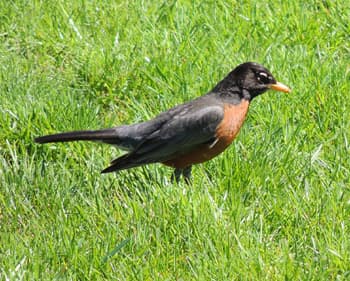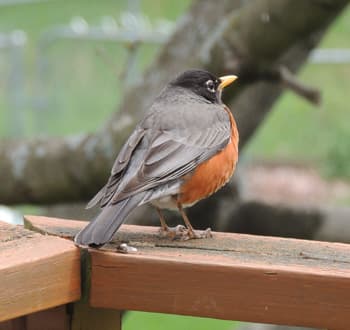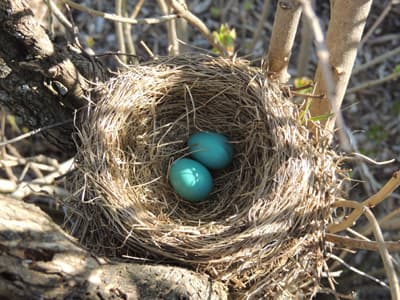
The American Robin is one of the most common birds in North America. Robins are the most recognizable backyard birds. Their native range covers much of North America, from Canada down to Mexico. They winter in the southern areas of their range. This migratory songbird has an estimated population of over 320 million birds. Robins are early to rise, making them one of the earliest songbirds you hear in the morning. This bird is named after the European Robin, which looks similar. However, they are not related.
Robins are commonly found in woodlands forests, gardens, and suburban backyards.
Adult robins measure 9-11 inches. They are the largest member of the Thrush family. Their bodies have grayish tones with some black on their head and at the ends of their tail feathers. They are readily recognizable by their orange to reddish-orange belly. Males and females look very similar. The female’s belly is a little duller orange, with a brown tint to the head. They are hard to distinguish, except in the spring, when a big, fat robin is a sure sign of a female.
The average bird lives about 2 years. The oldest recorded robin was a banded bird that lived 14 years.
A Stately Bird: The American Robin is the state bird of Connecticut, Michigan, and Wisconsin.

Robins eat mostly worms, grubs, caterpillars, and grasshoppers. They search for insects by both sound and sight. They also eat ample amounts of fruits and berries, when available.
You will not see them at your backyard birdfeeder. They do not eat bird seeds.

Robins are one of the first birds to lay eggs in the spring. First, the female builds a nest of grass, small twigs, feathers, and even scraps of paper. She binds the nest together with mud. Then, the inside of the nest is lined with soft grasses. The nest is 5-11 feet above the ground, often in the nook of a tree.
The female lays 3-5 light blue eggs. The eggs hatch in 14 days. The mother feeds the chicks primarily worms. The chicks stay in the nest for two weeks. After leaving the nest, both parents help protect the fledgling birds and help them to feed. It is fun to watch them as they struggle to take their first flight while mom and dad protectively watch and encourage them.
Hawks, cats, and snakes are common predators of these birds. Many animals are a threat to eggs and young chicks. These include hawks, squirrels, raccoons, blue jays, crows, and ravens.
Find more information about your favorite backyard birds:

©1999-2024 GardenersNet.Com, All Rights Reserved